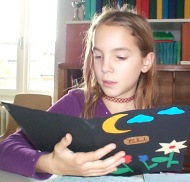|
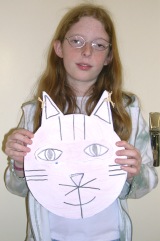
A letter sometimes looks like a booklet.


|
The letters come in all shapes and sizes. The children can give free rein to
their imagination.
Of course, some correspondents, especially the girls, were very popular
while others were neglected.
When only one pupil from my class wanted a particular penpal, no problem:
he/she could start writing their letter straight away.
If there was more than one pupil who wanted a particular penpal, I asked
them to write, in their turn, a letter of introduction so that their penpal of
choice could decide between them. Faced with so much uncertainty, some pupils
opted to play safe, by choosing one of the remaining penpals. Others
immediately put pen to paper, and attempted to write the best letter
possible...they had two weeks to do so.
Some of the pupils felt dejected when they were not chosen. The final
pairing up occurred quite rapidly after this and the correspondence could
become a 'routine'. All the children invested a lot of efforts and energy into
getting to know their penpal, and the knowledge that they would live with each
other for a week spurred them on even further.
|

Inside
page of another letter
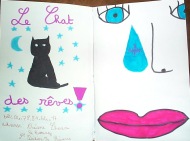
Other pages. All letters are different. The children's
dedication is enormous.
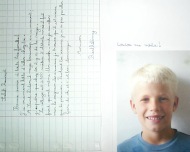
Inside pages of another letter. Generally, boys would
write more 'sobre' letters, but they were just as committed as the girls.
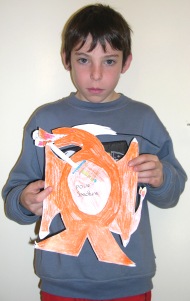
|
|
Individual correspondence
The letters from penpals are handed out as soon as they arrive. The
children keep an eye out for large parcels when I am sorting the post.
After a reading period, the children express themselves. Some of them
show the letter that they have received.
It is then our turn to write. From my experience, one of the potential
pitfalls of this exercise is that, if left to their own devices, the
children tend to repeat the same things in all their letters. To avoid
this, we all put together a 'portfolio of ideas'. We think about all new
things that have happened since our last letter, in the class, in the
school, in Saint-Didier, in the area, in the region, in France, and in the
world. I draw several columns on the board and note down their
suggestions. The children copy the suggestions that they like in their
notepads. They will then add what has happened to them personally, answer
their penpal's questions, and ask their own questions...
The children have one week to write their draft. They can do this in
class during periods for written expression, during the personal work
period, or at home. Another week is provided for correction and drawings.
I only correct the drafts that are left in my pigeonhole.
On posting day, we check that we have all the letters, and that every
letter has the penpal's name and has been signed. The children who are
particularly proud of their letter can show it to the others or post it on
the board - eventually, most pupils do this. Then either a pupil or me
goes to the post office.
|
|
Collective correspondence
Collective correspondence is alternated with individual correspondence.
This year, the themes were: the school, the neighbourhood and surrounding
area, Lyons. As with the 'portfolio of ideas', the children brainstorm
different topics, then they choose the ones that they will write about,
either individually or in twos. A group of children writes the collective
letter, integrating the various texts into a coherent whole. It is then
submitted to the class for approval.
|
|
|
Living with other families
The school exchange, whereby every child lives with their penpal's
family, is the pinnacle of the correspondence. It enables the children to
discover another region of France and to expand their horizons. This is a
real journey of discovery: the children are not mere tourists; they learn
that other people's houses are not the same as theirs, and also that
Brittany is not like Saint-Didier with the sea!
The families also arrange meetings and invitations of their own accord,
outside of the official exchange. And, eventually, thanks to our school,
real relationships are forged.
|
|
|
|
Other advantages
I will not dwell on the huge benefits that children derive from the
school correspondence and the exchange: motivation, intelligence in human
relations (with the penpal and their family), intelligence in one's
achievements (the letters and everything produced for the penpals), and
intelligence in real situations.
I also want to highlight two other non-trivial advantages for the
teacher. First, costs are minimised. Second, the teachers do not have to
keep an eye on the children all the time. After the school, the families
take charge of the children.
|
|
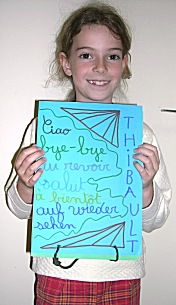
|
The risks
Essentially, it is the exchange that carries the most risks. There are
objective risks: we recognise that paedophilia, physical abuse and
alcoholism exist. With regard to these risks, the parents must place their
trust in the teacher at the other school, more specifically, in his/her
knowledge of the host families. There is also the subjective risk related
to families who refuse to entrust their child to another family. In such
cases, I suggest that the exchange proceed without them; over time, the
positive outcomes have reassured the parents (3).
Another problem has to do with differences in socioeconomic class.
Children from well-off families may live with a poor family, and vice
versa. In my opinion, this is an excellent experience, and, in all cases,
the children are warmly welcomed.
Another problem is broken families or step-families. From my experience,
I can say that all families try very hard to show their best side to the
children, and that, when a family has severe financial difficulties,
neighbouring families are more than willing to take charge of excursions
in the evenings and on Wednesdays.
|
(3) : At Crehen, it was the parents who taught Bernard
Grandclaudon about school correspondence. His successor was, in turn, also
initiated by the parents! In 2002-2003, the Crehen class exchanged with a
class from Eyzies.
|
